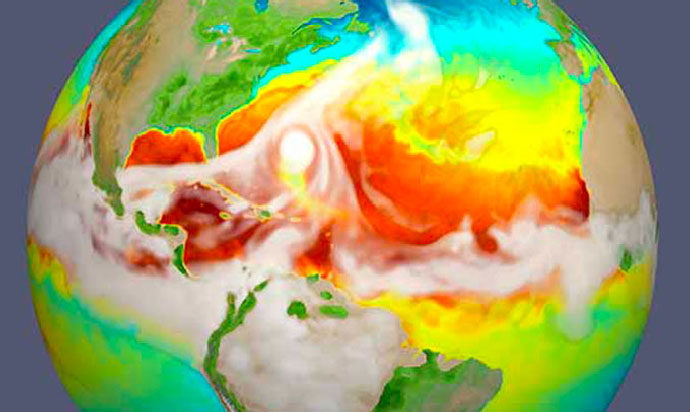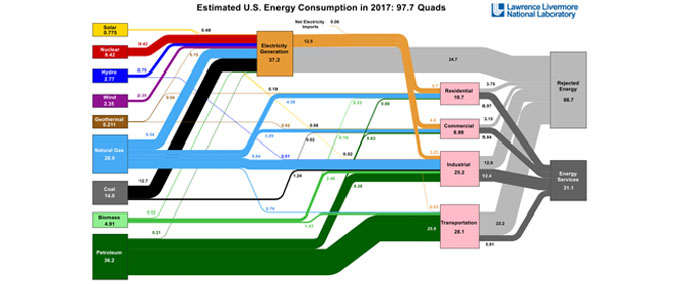Using science and technology to improve national energy security and surety, protect the environment, and understand and mitigate climate change
Laboratory researchers apply leading-edge capabilities to develop efficient and environmentally benign energy technologies and to investigate the processes that lead to climate change.
Simulating Earth’s Complexity
After four years of development, version one of the Energy Exascale Earth System Model (E3SM) was unveiled to the scientific community. The continuing project’s goal is to take advantage of supercomputers’ increasing power to more reliably simulate aspects of earth system variability and project decadal changes that will critically impact the U.S. energy sector in the near future. E3SM represents the myriad interactions of atmosphere, oceans, land, and ice by solving approximations of physical, chemical, and biological governing equations. Continued enhancements to E3SM aim to better represent earth system processes and increase resolution. These efforts are proceeding in tandem with DOE’s Exascale Computing Initiative to develop computer systems capable of carrying out a billion billion calculations per second. In a related new initiative, Laboratory scientists are collecting, archiving, and documenting climate data sets to support coordinated modeling efforts that study past, present, and future climates. Called the input data sets for model intercomparison projects (input4MIPs), the initiative aims to improve transparency, documentation, and consistency in the data sets used in climate simulations.
The Power of Microbes
Laboratory scientists in collaboration with Southern California Gas Company and Stanford University are using microbes and excess electricity produced by clean energy to convert carbon dioxide (CO2) to methane (natural gas). The project aims to develop the prototype of a reactor to be used at biogas sources such as feed lots, farms, wastewater treatment plants, and landfills. Biogas is mostly methane, however it contains about 40 percent CO2. The reactors would jointly reduce CO2 emissions and store excess solar and wind energy as useable natural gas. Livermore’s advances in 3D-printed carbon aerogel electrodes, to be used as efficient reactor materials, are key to the project’s success. In a related effort, Laboratory scientists are working to improve the energy efficiency of copper-based catalysts for converting CO2 into methane. The effort teams LLNL’s supercomputing and advanced manufacturing resources with the laboratories of Silicon Valley-based Opus 12.
Loss of Arctic Sea Ice
A study by Laboratory researchers shows that over the next few decades the loss of ice in the Arctic Ocean could significantly affect California precipitation patterns. The study, part of a broad Livermore effort addressing climate change, used supercomputer simulations to identify a new link between the loss of Arctic sea ice and an atmospheric ridge in the North Pacific. Sea ice fluctuations can lead to convection changes over the tropical Pacific. These convection changes can in turn drive the formation of an atmospheric ridge in the North Pacific. The ridge steers wet tropical air masses away from California, thereby reducing rainfall in the state. Another study involving scientists from the Laboratory and five other organizations found that human influences significantly impact the magnitude of the seasonal temperature cycle at mid-latitude regions of Northern Hemisphere continents. Satellite temperature data are consistent with the model projections, indicating that this cycle is becoming stronger with more frigid winters and hotter summers due to human emissions of CO2.
Partnerships with U.S. Industry
In FY 2018, DOE’s Advanced Manufacturing Office announced two rounds of new awards in its High-Performance Computing for Manufacturing program (HPC4Mfg). The program leverages DOE’s HPC resources to bolster U.S. manufacturing and clean-energy technologies. Laboratory researchers began work with Vitro Flat Glass to develop a neural network model for glass furnace operations, and LLNL initiated a project with KeraCel on manufacturing solid-state lithium-ion batteries. In addition, Lawrence Livermore and Argonne national laboratories are partnering with VAST Power Systems to optimize gas turbine combustors.
Since its inception in 2015, the HPC4Mfg program has been led by Lawrence Livermore in partnership with Oak Ridge and Lawrence Berkeley national laboratories. This year, DOE’s Office of Fossil Energy launched a complementary new initiative to fund private–public partnerships aimed at using DOE HPC systems and expertise to discover, design, and scale up production of novel materials for use in challenging environments. This new HPC for Materials for Severe Environments program is also led by Livermore.
Optimizing Automobile Fuels
LLNL scientists are developing models of high-performance fuels to determine how they would work in advanced internal combustion engines. The research is part of a DOE national effort to provide industry with the scientific underpinnings needed to accelerate introduction of high-performance fuels and engines that reduce energy consumption, improve air quality, and lower drivers’ costs. Called the Co-Optimization of Fuels and Engines, the initiative involves a collaboration between nine DOE national laboratories and industry in an effort to combine biofuels and combustion research and development. The Laboratory’s combustion kinetics models are used, among other purposes, to identify optimum fuel blends from different chemical families.







